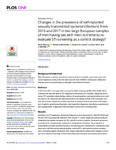2021-03-15Zeitschriftenartikel
Changes in the prevalence of self-reported sexually transmitted bacterial infections from 2010 and 2017 in two large European samples of men having sex with men–is it time to reevaluate STI-screening as a control strategy?
Marcus, Ulrich
Mirandola, Massimo
Schink, Susanne B.
Gios, Lorenzo
Schmidt, Axel J.
Background/Objectives
Many European countries reported increased numbers of syphilis, gonorrhoea and chlamydia diagnoses among men who have sex with men (MSM) in recent years. Behaviour changes and increased testing are thought to drive these increases.
Methods
In 2010 and 2017, two large online surveys for MSM in Europe (EMIS-2010, EMIS-2017) collected self-reported data on STI diagnoses in the previous 12 months, diagnostic procedures, STI symptoms when testing, number of sexual partners, and sexual behaviours such as condom use during the last intercourse with a non-steady partner in 46 European countries. Multivariate regression models were used to analyse factors associated with diagnoses of syphilis, gonorrhoea/chlamydia, and respective diagnoses classified as symptomatic and asymptomatic. If applicable, they included country-level screening rates.
Results
Questions on STI diagnoses and sexual behaviours were answered by 156,018 (2010) and 125,837 (2017) participants. Between 2010 and 2017, overall diagnoses with gonorrhoea/chlamydia and syphilis increased by 76% and 83% across countries. Increases were more pronounced for asymptomatic compared to symptomatic infections. The proportion of respondents screened and the frequency of screening grew considerably. Condomless anal intercourse with the last non-steady partner rose by 62%; self-reported partner numbers grew. Increased syphilis diagnoses were largely explained by behavioural changes (including more frequent screening). Gonorrhoea/chlamydia increases were mainly explained by more screening and a change in testing performance. A country variable representing the proportion of men screened for asymptomatic infection was positively associated with reporting symptomatic gonorrhoea/chlamydia, but not syphilis.
Discussion/Conclusion
The positive association of country-level screening rates with the proportion of symptomatic infections with gonorrhoea/chlamydia may indicate a paradoxical effect of screening on incidence of symptomatic infections. Treatment of asymptomatic men might render them more susceptible to new infections, while spontaneous clearance may result in reduced susceptibility. Before expanding screening programmes, evidence of the effects of screening and treatment is warranted.
Files in this item

